

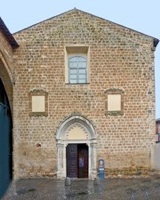
This deconsecrated church was restored in the 1980s and the church has recently been adapted to house the collection of Baroque sculpture of the Museo dell' Opera del Duomo.
Origins
The original church on this site, which was dedicated as Santa Lucia, belonged to the Premonstratensian canons of the Abbazia di SS Severo e Martirio. A community of monks from an order known as the Hermits of St William (Ordine Guglielmino) that had been established at nearby San Giovenale joined the canons here in 1248.
In ca. 1255, a number of other eremetical communities that had lived in the vicinity of Orvieto converged on this site, which their prior, Ranaldo Agostino bought from the Premonstratensian canons. In 1263, Cardinal Anchero (or Antero) Pantaleone de Troyes, a nephew of Pope Urban IV, formalised the community within the Augustinian Order.
The friars intended to use the old church of Santa Lucia on a temporary basis and then to demolish it when their new church (see below) was ready.
"New" Church
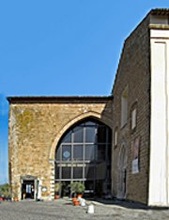
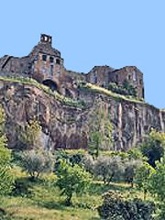
The friars laid the foundation of a huge new church in 1264. They designed it with its axis roughly at right angles to that of Santa Lucia and its apse overhanging the edge of the cliff. However, this project proved to be too ambitious, and it was abandoned in the middle of the 14th century.
The presence of the huge arch in what is now the end wall of the new structure suggests that facade and one or more bays of the new structure were demolished at some point to allow the facade of Santa Lucia to be moved forward (i.e. to the left in the photograph above).
The abandoned church now houses the Ristorante Al San Giovenale.
Adaptation of Santa Lucia
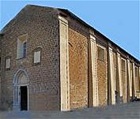
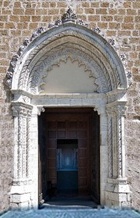
The modifications to the ancient building created a chronically unstable structure. After a number of failed attempts to rectify the situation, a series buttresses were built against the right wall in the 18th century. (A similar series on the left wall is visible from the garden).
The Augustinian community was suppressed in 1810. The friars from San Francesco moved here in 1816 until [when ??], when the complex was adapted for use by the military.
Interior
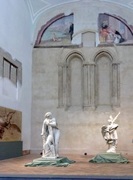
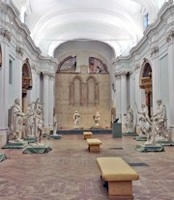
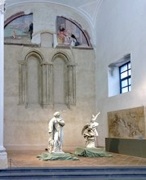
The interior of the church was completely remodelled in 1724. In effect, a new church was built inside the old one. The bifore windows of the back wall of the apse were closed and a trompe d’ oeil window was painted in fresco on the left wall to match the window opposite. (The statues in these photographs came from the Duomo and are now exhibited here).
Art from the Church
Sant’ Agostino Polyptych (1481)
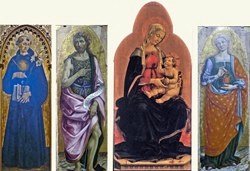
Panels from this polyptych include the following:
-
✴The central panel, which is dated by inscription, is now in the Gemaeldegalerie, Staatliche Museen, Berlin. It depicts the Madonna and Child: the baby Jesus holds a pomegranate and offers a seed from it to His Mother.
-
✴Two side panels, which depict SS Mary Magdalen and John the Baptist, are now in the Staatliches Lindenau Museum, Altenburg, Germany.
-
✴A side panel of St Nicholas of Tolentino is now in the Johnson Collection of the Philadelphia Museum of Art.
In 1927, Roberto Longhi attributed the dated panel in Berlin to the Master of the Gardner Annunciation. Federico Zeri’s accepted this attribution in 1953, when he identified this artist as Pier Matteo d' Amelia. He subsequently found a fifth panel from the polyptych, which depicted St Augustine trampling on two prostrate Arians, in the Watney Collection, Cornbury Park, Oxfordshire. It was sold in 1967, after which all trace was lost.
The presence of SS Augustine and Nicholas of Tolentino suggested that the polyptych came from an Augustinian church. In 1980, Filippo Todini discovered that the four side panels had all belonged to the collection of Agostino Mariotti in Rome in the 18th century. Since this collection contained mostly works from Orvieto, he suggested that the polyptych had been commissioned for Sant’ Agostino.
In 1992, Laura Andreani published documents that she had discovered in the archives of Orvieto:
-
✴two recorded the friars’ decision to sell property in 1478 in order to finance the commission of a new altarpiece for the high altar;
-
✴a third documented a further sale in 1479 and part payment to Pier Matteo d’ Amelia, who was then at work on the commission; and
-
✴a fourth recorded the satisfactory delivery of the work in 1481.
The aged Pietro di Nicola Baroni provided the valuation of the work on completion.
Madonna and Child with saints (1713-4)
This altarpiece [the deposit of the Museo dell’ Opera del Duomo] depicts the Madonna and Child in glory with SS Augustine and Monica. St Monica holds the Virgin’s belt, which she has received from the baby Jesus. In the list of his works that Ludovico Mazzanti recorded in 1770, he noted that he had painted it for his family chapel in Sant’ Agostino.

